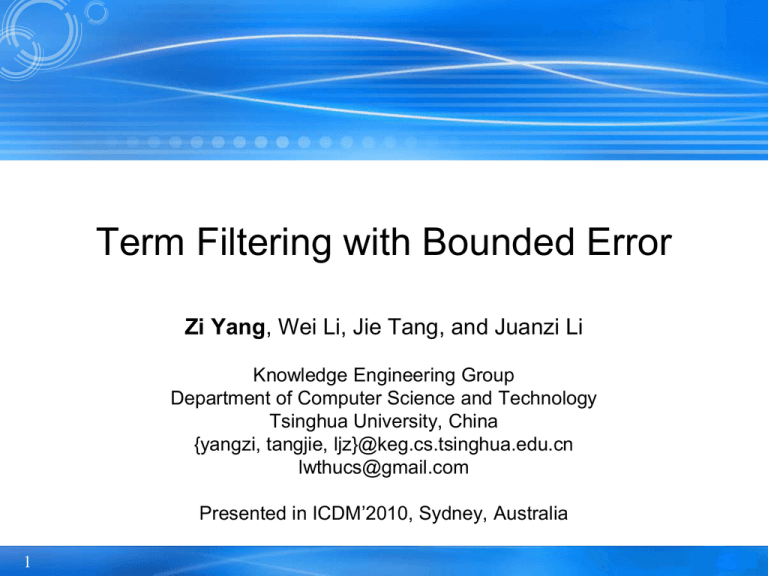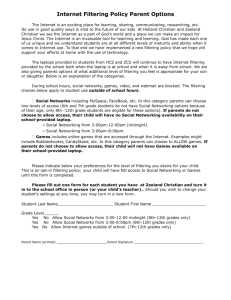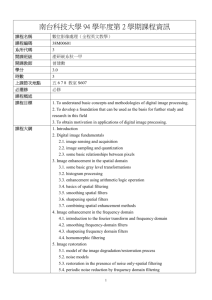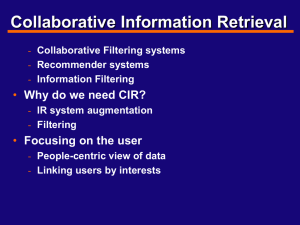Yang-Term-Filtering... - School of Computer Science
advertisement

Term Filtering with Bounded Error
Zi Yang, Wei Li, Jie Tang, and Juanzi Li
Knowledge Engineering Group
Department of Computer Science and Technology
Tsinghua University, China
{yangzi, tangjie, ljz}@keg.cs.tsinghua.edu.cn
lwthucs@gmail.com
Presented in ICDM’2010, Sydney, Australia
1
Outline
•
•
•
•
•
•
2
Introduction
Problem Definition
Lossless Term Filtering
Lossy Term Filtering
Experiments
Conclusion
Introduction
• Term-document correlation matrix
– 𝑀: a |𝑉| × |𝐷| co-occurrence matrix,
the number of times
that term 𝑤𝑖 occurs in
document 𝑑𝑗
How can we overcome
the disadvantage?
– Applied in various text mining tasks
• text classification [Dasgupta et al., 2007]
• text clustering [Blei et al., 2003]
• information retrieval [Wei and Croft, 2006].
– Disadvantage
• high computation-cost and intensive memory access.
3
Introduction (cont'd)
• Three general methods:
– To improve the algorithm itself
– High performance platforms
• multicore processors and distributed machines [Chu
et al., 2006]
– Feature selection approaches
• [Yi, 2003]
We follow this line
4
Introduction (cont'd)
• Basic assumption
– Each term captures more or less information.
Limitations
• Our goal
- A generic definition of information
– A subspace
of afeatures
(terms)
loss for
single term
and a set of
– Minimal
information
terms
in termsloss.
of any metric?
• Conventional
solution: loss of each
- The information
– Step 1:
Measure document,
each individual
individual
andterm
a setorofthe
dependency
to a group of terms.
documents?
• Information gain or mutual information.
– Step 2: Remove
features
with
low
scores
in
Why should we consider the
importance or high scores in redundancy.
information loss on documents?
5
Introduction (cont'd)
• Consider a simple example:
w
(2,
2)
A
Doc 1
Doc 2
AA B
AA B
What we have done?w (1,1)
B
- Information loss for both terms and
• Question:
any loss of information if A and B
documents
are- Term
substituted
a Bounded
single term
Filteringby
with
ErrorS?
problem
- Developonly
efficient
algorithms loss for terms
– Consider
the information
•YES! Consider that 𝜖𝑉 is defined by some state-ofthe-art pseudometrics, cosine similarity.
– Consider both
•NO! Because both documents emphasize A more
than B. It’s information loss of documents!
6
Outline
•
•
•
•
•
•
7
Introduction
Problem Definition
Lossless Term Filtering
Lossy Term Filtering
Experiments
Conclusion
Problem Definition - Superterm
• Want
– less information loss
– smaller term space
Group terms into superterms!
• Superterm: 𝑠 = {𝑛(𝑠, 𝑑𝑗 )}𝑗 .
8
the number of occurrences of
superterm 𝑠 in document 𝑑𝑗
Problem Definition – Information loss
• Information loss during term merging?
– user-specified
measures 𝑑(⋅,⋅)
Can be chosendistance
with different
methods: winner-take-all,
• Euclidean
metric and cosine similarity.
average-occurrence, etc.
– superterm 𝑠 substitutes a set of terms 𝑤𝑖
• information loss of terms error𝑉 (𝑤) = 𝑑(𝐰, 𝐬).
• information loss of documents error𝐷 (𝑑) = 𝑑(𝐝, 𝐝′).
Doc 1
AA B
Doc 1
A
B
9
Doc 2
A transformed representation
for document 𝑑 after merging
AA B
Doc 1
Doc 2
2 2
1 1
S
S
Doc 2
1.5 1.5
1.5 1.5
errorW 0
errorD 0
Problem Definition – TFBE
• Term Filtering with Bounded Error
(TFBE)
– To minimize the size of superterms |𝑆| subject
to the following constraints:
(1) 𝑆 = 𝑓(𝑉) = ∐𝑠∈𝑆 𝑠,
(2) for all 𝑤 ∈ 𝑉, error𝑉 (𝑤) ≤ 𝜖𝑉 ,
(3) for all 𝑑 ∈ 𝐷, error𝐷 (𝑑) ≤ 𝜖𝐷 .
Mapping function
from terms to
superterms
10
Bounded by userspecified errors
Outline
•
•
•
•
•
•
11
Introduction
Problem Definition
Lossless Term Filtering
Lossy Term Filtering
Experiments
Conclusion
Lossless Term Filtering
• Special case
– NO information loss of any term and document
𝜖𝑉 = 0 and 𝜖𝐷 = 0
• Theorem: The exact optimal solution of the
problem is yielded by grouping terms of the
same vector
Thisrepresentation.
case is applicable?
• YES!
Algorithm
On Baidu Baike dataset (containing
– Step 1: find “local” superterms for each document
1,531,215
documents)
• Same occurrences within the document
The
vocabulary
sizeor
1,522,576
-> 714,392from
– Step
2: add, split,
remove superterms
global superterm set> 50%
12
Outline
•
•
•
•
•
•
13
Introduction
Problem Definition
Lossless Term Filtering
Lossy Term Filtering
Experiments
Conclusion
Lossy Term Filtering
• General case
𝜖𝑉 > 0 and 𝜖𝐷 > 0
• A greedy algorithm
NP-hard!
reduce
the size
ofby 𝜖𝑉 .
– Step Further
1: Consider
the constraint
given
• Similar
to Greedy Cover
Algorithm
candidate
superterms?
– Step
2: Verify the validity of
the candidates
Locality-sensitive
hashing
(LSH)with
𝜖𝐷 .
• Computational Complexity
#iterations << |V|
– 𝑂(|𝑉|2 + |𝑉|𝑇|𝐷| + 𝑇 ′ (|𝑉|2 + 𝑇|𝐷|))
– Parallelize the computation for distances
14
Efficient Candidate Superterm
Generation
• LSH
• Basic idea:
Same hash value
a projection vector(with several randomized
hash projections)
(drawn from the
Gaussian
distribution)
Now
search
𝑤(𝜖Close
𝑉 )-near
to each other
(in the
original space)
neighbors in all the
buckets!
• Hash function for the
Euclidean distance
𝐫⋅𝐰+𝑏
ℎ 𝐰 =
the width of the𝑟,𝑏
𝑤(𝜖𝑉 )
(Figure modified based on http://cybertron.cg.tubuckets [Datar et al., 2004].
berlin.de/pdci08/imageflight/nn_search.html)
(assigned empirically)
15
Outline
•
•
•
•
•
•
16
Introduction
Problem Definition
Lossless Term Filtering
Lossy Term Filtering
Experiments
Conclusion
Experiments
• Settings
– Datasets
• Academic: ArnetMiner (10,768 papers and 8,212
terms)
• 20-Newsgroups (18,774 postings and 61,188 terms)
– Baselines
• Task-irrelevant feature selection: document
frequency criterion (DF), term strength (TS), sparse
principal component analysis (SPCA)
• Supervised method (only on classification): Chistatistic (CHIMAX)
17
Experiments (cont'd)
• Filtering results on Euclidean metric
– Findings
• Errors ↑, term radio ↓
• Same bound for terms,
bound for documents ↑,
term ratio ↓
• Same bound for
documents, bound for
terms ↑, term ratio ↓
18
Experiments (cont'd)
• The information loss in terms of error
Avg. errors
19
Max errors
Experiments (cont'd)
• Efficiency Performance of Parallel
Algorithm and LSH*
* Optimal resulting from different choice of 𝑤 𝜖𝑉 tuned
20
Experiments (cont'd)
• Applications
– Classification (20NG)
– Clustering (Arnet)
– Document retrieval (Arnet)
21
Outline
•
•
•
•
•
•
22
Introduction
Problem Definition
Lossless Term Filtering
Lossy Term Filtering
Experiments
Conclusion
Conclusion
• Formally define the problem and perform a
theoretical investigation
• Develop efficient algorithms for the
problems
• Validate the approach through an extensive
set of experiments with multiple real-world
text mining applications
23
Thank you!
24
References
• Blei, D. M., Ng, A. Y. and Jordan, M. I. (2003). Latent Dirichlet
Allocation. Journal of Machine Learning Research 3, 993-1022.
• Chu, C.-T., Kim, S. K., Lin, Y.-A., Yu, Y., Bradski, G., Ng, A. Y.
and Olukotun, K. (2006). Map-Reduce for Machine Learning on
Multicore. In NIPS '06 pp. 281-288,.
• Dasgupta, A., Drineas, P., Harb, B., Josifovski, V. and Mahoney,
M. W. (2007). Feature selection methods for text classification.
In KDD'07 pp. 230-239,.
• Datar, M., Immorlica, N., Indyk, P. and Mirrokni, V. S. (2004).
Locality-sensitive hashing scheme based on p-stable
distributions. In SCG'04 pp. 253-262,.
• Wei, X. and Croft, W. B. (2006). LDA-Based Document Models
for Ad-hoc Retrieval. In SIGIR '06 pp. 178-185,.
• Yi, L. (2003). Web page cleaning for web mining through
feature weighting. In IJCAI '03 pp. 43-50,.
25





